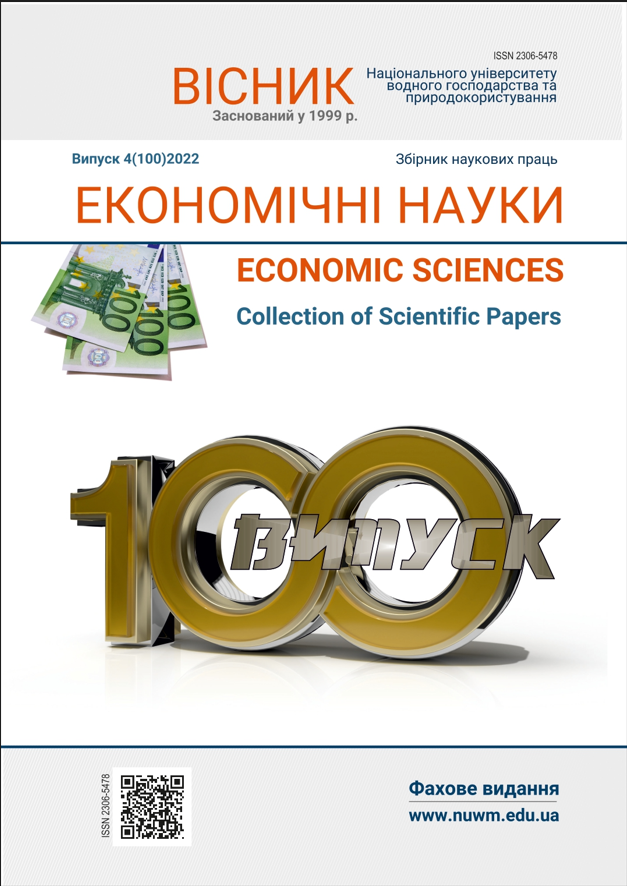POPULATION INCOME: THEORETICAL ASPECT, STRUCTURAL AND DYNAMIC CHARACTERISTICS OF THE FORMATION IN UKRAINE
DOI:
https://doi.org/10.31713/ve4202220Keywords:
income, income formation, primary income, secondary income, salary, profit, social transfers, pension provision.Abstract
The paper summarizes theoretical studies on the determination of the essence, factors of formation, and classification of incomes of the population. According to the criterion of participation in social production, incomes are divided into factor incomes (including entrepreneurial profit, wages, rents) and transfers (pensions, scholarships, social benefits).According to the method of formation, primary and secondary incomes are distinguished. The author proposes his own approach to structuring the factors that affect income by levels of their formation. Among them are economic and socio-demographic factors. A comparative analysis of the dynamics of GDP per capita in Ukraine and the EU as a prerequisite for the formation of the level of income of the population is carried out. The dynamics of the main indicators of nominal and real incomes of the population in Ukraine is studied (the latter significantly decreased in 2014–2016).In the structure of the population’s income, wages, social benefits and other current transfers, profits remain invariably the most significant. The peculiarities of the formation of the level and structure of incomes of the population of Ukraine by such criteria as place of residence, composition of households, their decile distribution, as well as economic zoning are revealed. The highest level of income in Ukraine is in urban areas. Urban residents on average have a significantly higher share of wages in their incomes compared to rural residents. Significantly lower income levels in Ukraine are found in those households that include persons of retirement age and consist of four or more persons. The decile distribution of households in Ukraine shows their significant differentiation by income. The highest share of wages in total income is observed in the seventh tenth decile group, and pensions – in the first decile. The highest level of income is in the Central and Carpathian regions, the lowest – in the Eastern region. The amount, share and internal structure of primary and secondary incomes of the population in Ukraine are determined. The share of primary income in Ukraine prevails and is slightly increasing over time. At the same time, the share of secondary income slightly decreased during 2014–2021. Thestructure of primary income is dominated by wages and salaries and mixed income, while secondary income is dominated by social assistance and other current transfers.References
Доходи та заощадження в перехідній економіці України / ред. С. Панчишина та М. Савлука. Львів, 2003. С. 406.
Cаввов А. А. Доходи населення України та їх динаміка. Формування ринкових відносин в Україні. 2009. № 2. С. 121–126.
Абакумова Н. М. Политика доходов и заработной платы : учеб. пособие / ред. Н. М. Абакумова, Р. Я. Подовалова / Новосибирская гос. академия экономики и управления. Москва : Инфра-С. 2002. С. 224.
Баланда А. Л. Диференціація населення України за рівнем доходів та її вплив на соціальну напругу. Вісник БУМіБ. 2008. № 4 (4). С. 91–95.
Гвелесіані А. Г. Диференціація грошових доходів населення: аналіз, прогноз та механізм регулювання : монографія / відп. ред. В. М. Новіков. Київ, 2008. 155 с.
Гудима О. В. Шляхи удосконалення доходів і видатків населення. Держава та регіони. 2008. № 4. С. 42–46.
Кваснікова Г. С. Доходи населення та економічний стан держави. Актуальні проблеми економіки. 2009. С. 53−60.
Лібанова Е. М. Нерівність в українському суспільстві: витоки та сучасність. Економіка України. 2014. № 3. С. 4–19.
Новий економічний словник / ред. А. Н. Азріліяна. Москва : Інститут нової економіки, 2006. С. 1088.
Новіков В. М., Семенов В. В. Актуальні питання структурного аналізу і прогнозування доходів населення. Економіка України. 2005. № 7. С. 74–82.
Перерва П. Г., Погорелова Н. И., Дюжева Г. В. Экономика и организация труда. Харьков : НТУ «ХПИ», 2006. С. 588.
Полякова С. В. Новосільська Т. В. Бідність населення за споживанням: нові виміри. Демографія та соціальна економіка. 2015.
№ 1. С. 22–31.
Полякова С. В. Територіальна диспропорційність рівня життя населення: теоретичні аспекти дослідження. Демографія та соціальна економіка. 2014. № 2 (22). C. 198–207.
Стожок О. З. Формування і розподіл доходів населення в умовах трансформації економіки : автореф. дис. … канд. екон. наук : 08.09.01. Донецьк, 2008. 220 с.
Тютюнникова С. В. Формирование доходов населения в условиях рыночной трансформации. Харьков : Основа, 2004. С. 209.
Черенько Л. М. Нерівність у доходах: стан і можливі наслідки та шляхи подолання негативних тенденцій. Демографія та соціальна економіка. 2004. № 1–2. С. 110–115.
Дутчак А. В. Соціально-економічний механізм функціонування ринкового розподілу доходів : дис. … канд. екон. наук : 08.00.01. Чернівці, 2015. 250 с.
Приймак З. В. Функціональний розподіл доходів в економіці України : дис. … канд. екон. наук : 08.00.01. Львів, 2015. 204 с.
Дворник І. В. Теоретикометодологічні засади формування рівня доходів сільського населення. Науковий вісник Національного університету біоресурсів і природокористування України. Сер. Економіка, аграрний менеджмент, бізнес. 2013. Вип. 181(4). С. 114–122.

